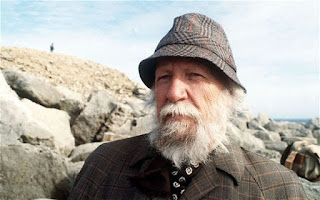SEAMUS HEANEY (1939 –2013), IRISH POET
"The cold smell of potato mould, the squelch and slap
Of soggy peat, the curt cuts of an edge
Through living roots awaken in my head.
But I’ve no spade to follow men like them.
Between my finger and my thumb
The squat pen rests.
I’ll dig with it."
"God is a foreman with certain definite views
Who orders life in shifts of work and leisure."
"Dispraise the catch, and smile
As you find a rhythm
Working you, slow mile by mile,
Into your proper haunt
Somewhere, well out, beyond..."
"Honeymooning, moonlighting, late for the Proms,
Our echoes die in that corridor and now
I come as Hansel came on the moonlit stones
Retracing the path back, lifting the buttons."
"Who would connive
in civilized outrage
yet understand the exact
and tribal, intimate revenge."
"All I know is a door into the dark."
"A people hungering from birth,
grubbing, like plants, in the bitch earth,
were grafted with a great sorrow."
"Wearing a poppy bruise on his left temple,
He lay in the four foot box as in his cot,
No gaudy scars, the bumper knocked him clear.
A four foot box, a foot for every year."
"How culpable was he
That last night when he broke
Our tribe's complicity?
'Now, you're supposed to be
An educated man,'
I hear him say. 'Puzzle me
The right answer to that one."
"History says, don’t hope
On this side of the grave.
But then, once in a lifetime
The longed-for tidal wave
Of justice can rise up,
And hope and history rhyme."
"The cold smell of potato mould, the squelch and slap
Of soggy peat, the curt cuts of an edge
Through living roots awaken in my head.
But I’ve no spade to follow men like them.
Between my finger and my thumb
The squat pen rests.
I’ll dig with it."
~ Seamus Heaney, Digging
"God is a foreman with certain definite views
Who orders life in shifts of work and leisure."
~ Seamus Heaney, Docker
"Dispraise the catch, and smile
As you find a rhythm
Working you, slow mile by mile,
Into your proper haunt
Somewhere, well out, beyond..."
~ Seamus Heaney, Casualty
"Honeymooning, moonlighting, late for the Proms,
Our echoes die in that corridor and now
I come as Hansel came on the moonlit stones
Retracing the path back, lifting the buttons."
~ Seamus Heaney, The Underground
"Who would connive
in civilized outrage
yet understand the exact
and tribal, intimate revenge."
~ Seamus Heaney, Punishment
"All I know is a door into the dark."
~ Seamus Heaney, The Forge
"A people hungering from birth,
grubbing, like plants, in the bitch earth,
were grafted with a great sorrow."
~ Seamus Heaney, At a Potato Digging
"Wearing a poppy bruise on his left temple,
He lay in the four foot box as in his cot,
No gaudy scars, the bumper knocked him clear.
A four foot box, a foot for every year."
~ Seamus Heaney, Mid-Term Break
"How culpable was he
That last night when he broke
Our tribe's complicity?
'Now, you're supposed to be
An educated man,'
I hear him say. 'Puzzle me
The right answer to that one."
~ Seamus Heaney, Casualty
"History says, don’t hope
On this side of the grave.
But then, once in a lifetime
The longed-for tidal wave
Of justice can rise up,
And hope and history rhyme."
~ Seamus Heaney, The Cure at Troy


















